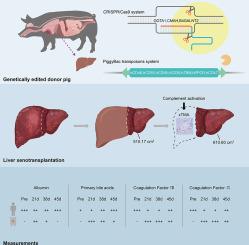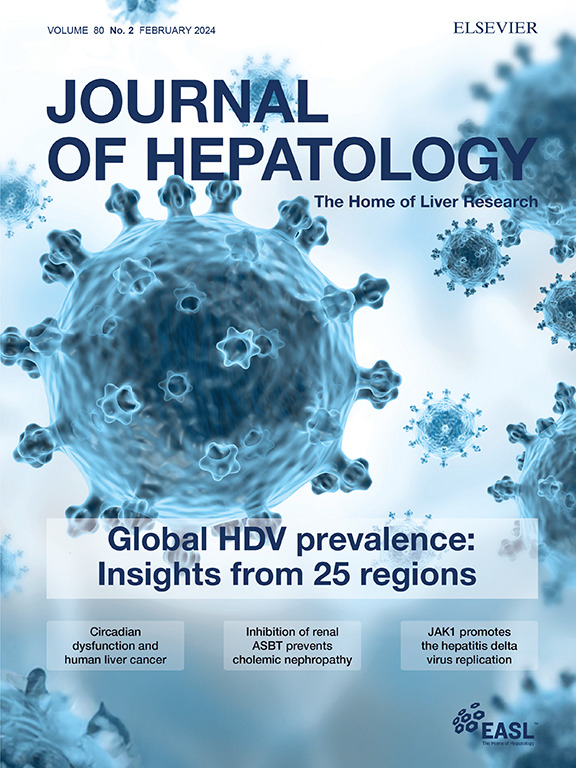Genetically engineered pig-to-human liver xenotransplantation
IF 33
1区 医学
Q1 GASTROENTEROLOGY & HEPATOLOGY
引用次数: 0
Abstract
Background
The advent of genetically edited porcine-to-human xenotransplantation has predominantly focused on cardiac and renal applications, with no reported cases of porcine-to-human liver xenotransplantation. This study presents the world’s first successful genetically modified pig auxiliary liver xenotransplantation in a living human, achieving an unprecedented survival of 171 days, and provides valuable insights into the critical factors influencing the procedure’s success.Methods
A genetically modified pig liver, incorporating 10 targeted gene edits, was transplanted as an auxiliary organ into a patient with large hepatocellular carcinoma in the right hepatic lobe, which was initially deemed ineligible for curative resection. Liver function, metabolic, and coagulation markers were closely monitored throughout the perioperative period.Results
For the first 31 days post-transplant, no hyperacute or acute rejection, infections, or significant complications were observed, and the patient’s hepatic and renal functions remained stable. Early postoperative coagulopathy, as indicated by elevated D-dimer and fibrin degradation products, was successfully managed through anticoagulant therapy. However, on postoperative day 38, the auxiliary liver was removed due to xenotransplantation-associated thrombotic microangiopathy (xTMA). Subsequent management with eculizumab and plasma exchange successfully resolved the xTMA. Unfortunately, repeated upper gastrointestinal hemorrhage ultimately led to the patient's death on day 171.Conclusions
This study demonstrates the feasibility of auxiliary porcine liver xenotransplantation as a bridging approach to human to liver transplantation. Postoperative xTMA presents a significant challenge to long-term success, highlighting the need for further research to improve xenotransplantation outcomes.Impact and implications
This study reports the world’s first auxiliary xenotransplantation from a 10-gene-edited pig to a living human recipient - distinct from previous studies involving brain-dead donors.The donor liver was engineered using a 10-gene editing platform, including the knockout of xenoantigen genes and the knock-in of seven human transgenes for immune and coagulation compatibility - pushing the boundaries of synthetic biology in clinical transplantation.The porcine graft exhibited metabolically active liver function, bile secretion, and coagulation correction, demonstrating not only survival but clinically meaningful function.Our work documents, for the first time, xenotransplantation-associated thrombotic microangiopathy (xTMA) in a living human recipient, with comprehensive immunological and histopathological analysis - critical knowledge for the field.

基因工程猪到人的肝脏异种移植
基因编辑的猪到人异种移植的出现主要集中在心脏和肾脏的应用,没有报道猪到人肝脏异种移植的病例。这项研究展示了世界上第一个成功的转基因猪辅助肝脏异种移植,在活人身上实现了前所未有的171天的存活,并为影响手术成功的关键因素提供了有价值的见解。方法将含有10个靶向基因编辑的转基因猪肝作为辅助器官移植到右肝叶大肝癌患者体内,该患者最初被认为不适合根治性切除。在整个围手术期密切监测肝功能、代谢和凝血指标。结果移植后31天无超急性或急性排斥反应,无感染,无明显并发症,肝肾功能稳定。术后早期凝血障碍,如d -二聚体和纤维蛋白降解产物升高所示,通过抗凝治疗成功控制。然而,在术后第38天,由于异种移植相关血栓性微血管病变(xTMA),辅助肝被切除。随后的eculizumab治疗和血浆置换成功地解决了xTMA。不幸的是,反复的上消化道出血最终导致患者在第171天死亡。结论辅助猪肝异种移植作为人肝移植的桥梁是可行的。术后xTMA对长期成功提出了重大挑战,强调需要进一步研究以改善异种移植结果。影响和意义这项研究报道了世界上第一次从10个基因编辑的猪到活的人类受体的辅助异种移植,这与之前涉及脑死亡供体的研究不同。供体肝脏使用10个基因编辑平台进行工程设计,包括敲除异种抗原基因和敲入7种人类转基因,以提高免疫和凝血相容性——这推动了合成生物学在临床移植中的界限。猪移植物表现出代谢活跃的肝功能、胆汁分泌和凝血纠正,不仅证明了生存,而且证明了有临床意义的功能。我们的工作首次记录了活体人类受体中异种移植相关的血栓性微血管病(xTMA),并进行了全面的免疫学和组织病理学分析-这是该领域的关键知识。
本文章由计算机程序翻译,如有差异,请以英文原文为准。
求助全文
约1分钟内获得全文
求助全文
来源期刊

Journal of Hepatology
医学-胃肠肝病学
CiteScore
46.10
自引率
4.30%
发文量
2325
审稿时长
30 days
期刊介绍:
The Journal of Hepatology is the official publication of the European Association for the Study of the Liver (EASL). It is dedicated to presenting clinical and basic research in the field of hepatology through original papers, reviews, case reports, and letters to the Editor. The Journal is published in English and may consider supplements that pass an editorial review.
 求助内容:
求助内容: 应助结果提醒方式:
应助结果提醒方式:


